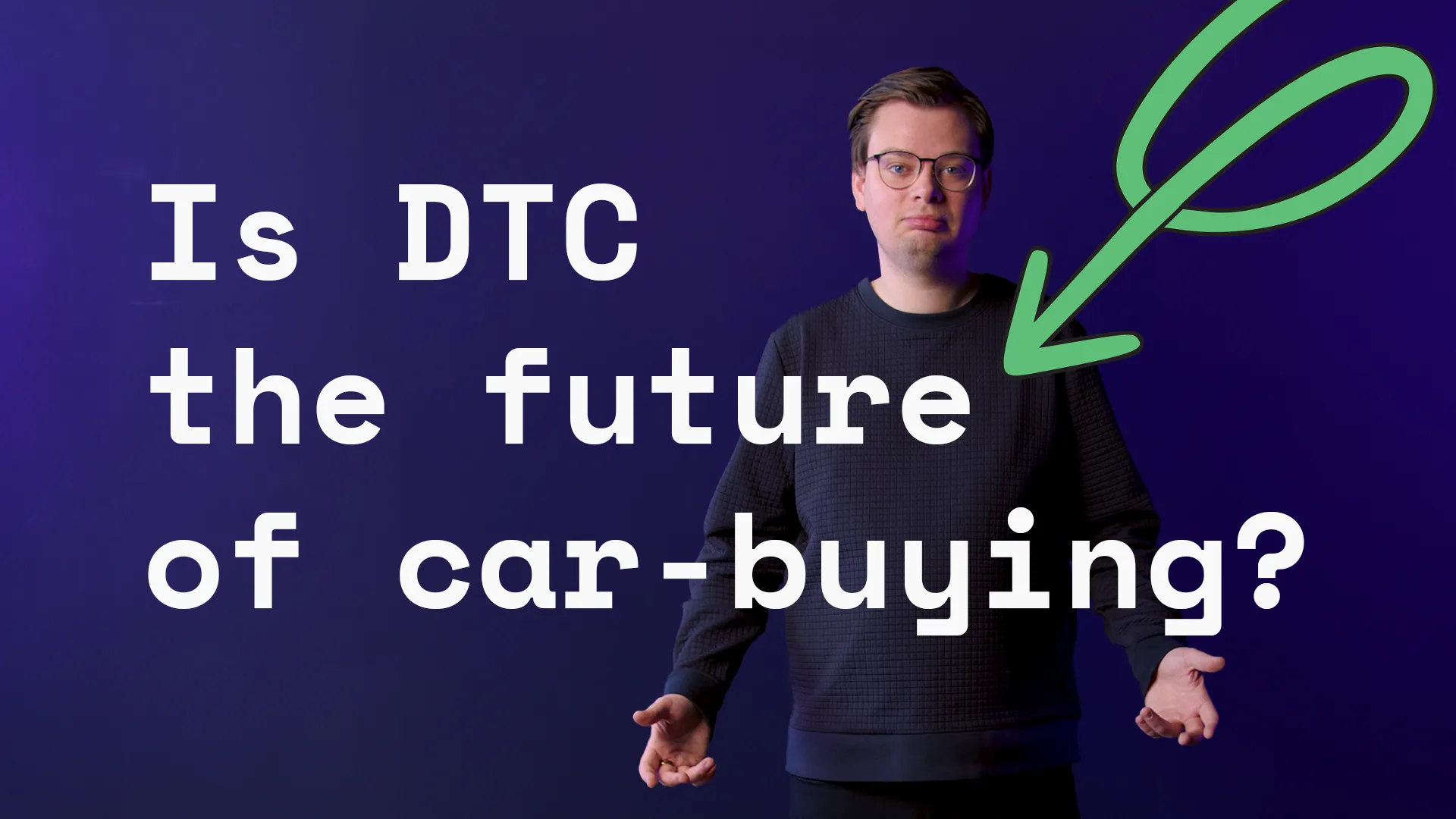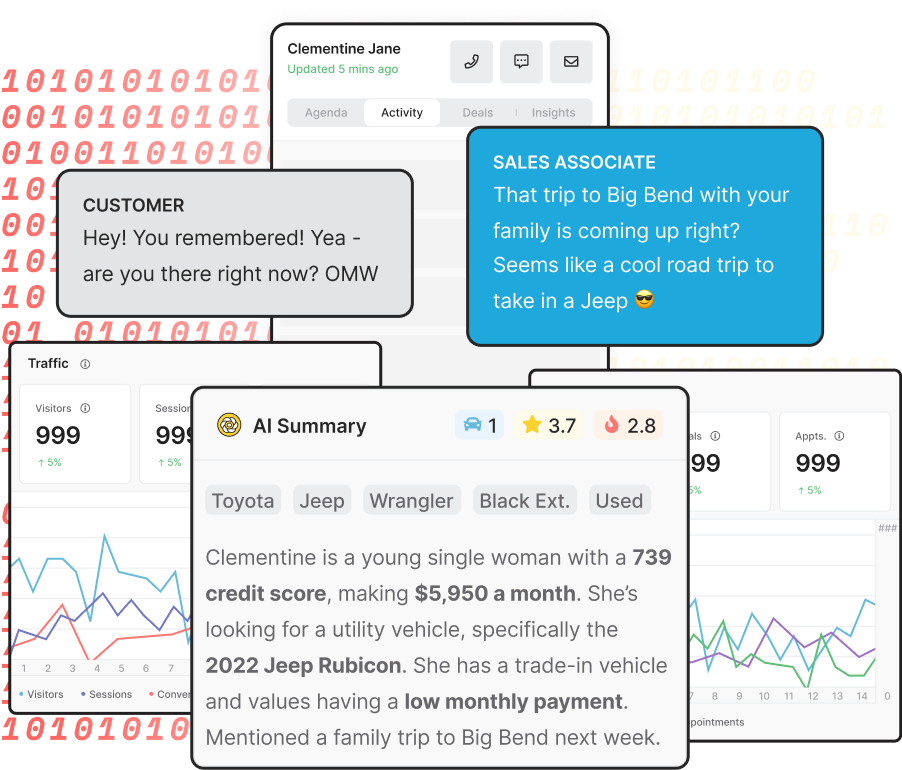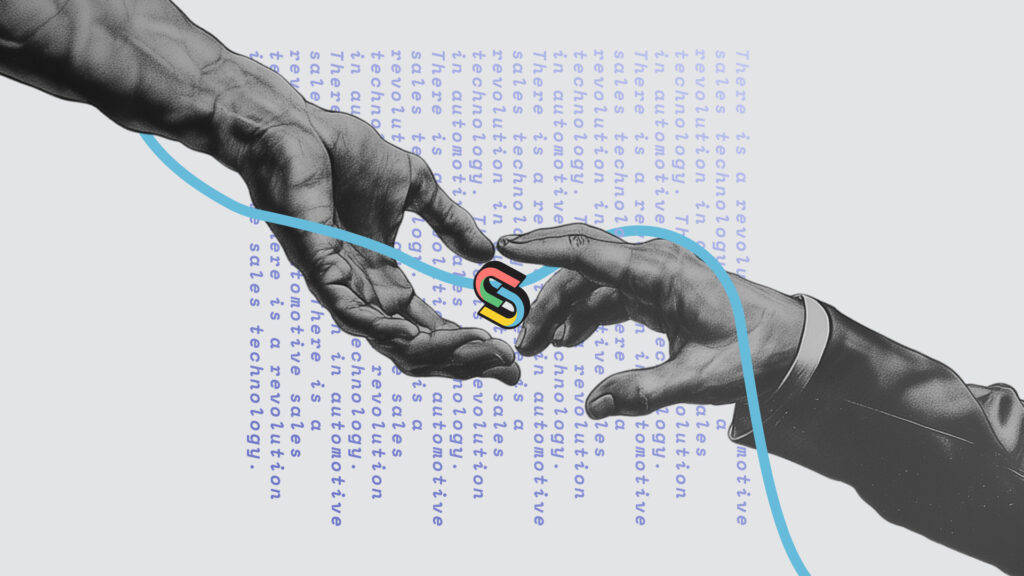
03/20/2025
Will Direct To Consumer Kill Dealersips?
Why Fully Online DTC Car Buying Isn’t the Future (and What Dealerships Can Do About It)
Despite the buzz around fully online, direct-to-consumer (DTC) car buying, it’s not going to replace your local car dealership anytime soon. Why? Most car shoppers simply aren’t ready to buy a big-ticket item like a car without some in-person interaction and trust. In fact, over 70% of Americans say they still want to buy their vehicle in person , and an overwhelming majority continue to purchase at dealerships – only about 6% bought their last car fully online from an online delivery website . Even among those who have bought a car online, two-thirds plan to go back to a dealership for their next purchase . The data is loud and clear: the future of car buying is hybrid – blending online convenience with the tried-and-true dealership experience.
Now, let’s dive into what today’s car buyers really want, and how dealerships can deliver the best of both worlds.
What Do Car Buyers Really Want? (Data-Driven Insights)
Shoppers love the convenience of online tools, but they also crave the confidence that comes from seeing a car and a trusted expert in person. Recent industry studies reveal a nuanced picture of car-buying preferences:
- Research Online, Buy Offline: A whopping 95% of car shoppers rely on online resources to gather information – browsing models, comparing prices, and reading reviews long before stepping into a showroom. But when it’s time to seal the deal, 61% still prefer to finalize the purchase at a dealership.
- In-Person Still Matters: 71% of American consumers want to buy in-person at a dealership, and 64% aren’t comfortable purchasing a car entirely online . It’s no surprise the majority (around 3 out of 4 buyers) continue to go the traditional route of visiting a dealership for the final transaction.
- Online-Only? Not So Fast: Fully online car sales (from companies like Carvana or Vroom) remain a niche portion of the market. In a 2023 survey, only 6% of buyers purchased via an online-only retailer . Meanwhile, 67% of online buyers said they’ll likely buy their next car at a dealership – indicating that after trying the all-digital route, many shoppers miss aspects of the dealership experience.
- Hybrid is on the Rise: 25% of buyers are open to purchasing a car online (up from 18% in 2021), yet an increasing 61% still favor the dealership for completing the sale . The remainder are undecided, suggesting people are experimenting but haven’t overwhelmingly shifted to click-to-buy for cars.
Why the Hesitation? Buying a car isn’t like buying a toaster. It’s a major financial decision with many variables. Shoppers cite things like the need to test drive and see the vehicle, desire for a personal touch in financing, and making sure they’re getting a fair deal as reasons they won’t go fully online. They want digital convenience and human reassurance.

The Appeal of DTC: What Customers Like About Buying Cars Online
Make no mistake, aspects of the DTC car-buying experience do appeal to modern consumers. Dealerships can learn a lot from what companies like Tesla, Carvana, and Rivian get right. Here are the key elements customers want from a DTC-style car purchase:
- No-Hassle, Upfront Pricing: Many buyers dread haggling over price. In fact, over 70% of car shoppers would rather get a fair, firm price without haggling than negotiate endlessly . DTC models often use one-price (no negotiation) strategies, which customers appreciate for the transparency and stress reduction.
- Convenience of Buying from the Couch: Online car buying means you can shop on your schedule. Customers love being able to complete big chunks of the process from home – from browsing inventory to applying for financing. According to one survey, 90% of auto consumers want to start the buying process online . They’d happily handle tasks like searching vehicles (80% of shoppers), checking prices (78%), valuing their trade-in (75%), and even arranging financing (74%) on a website.
- Faster, Streamlined Process: Time is money. The average buyer can spend 3–5 hours at a dealership completing a purchase . DTC platforms promise to cut this down by streamlining paperwork and eliminating dealership wait times. (No one enjoys camping out in the finance office for hours.) Online processes that let customers upload documents, e-sign, and schedule pickup or delivery make car buying feel quicker and more efficient.
- Low-Pressure Experience: Ever notice how Tesla doesn’t call its locations “dealerships”? They’re showrooms staffed with product specialists, not commission-based salespeople. The idea is to let customers explore at their own pace with zero pressure . Buyers appreciate feeling in control – they can take a test drive without a salesperson breathing down their neck, and ask questions without the hard sell. This relaxed, customer-centric vibe is a hallmark of DTC, and one that traditional dealers can emulate.
- Home Delivery & At-Home Test Drives: Picking up your new car from a giant vending machine or having it delivered to your doorstep is a novelty consumers find appealing. It’s convenient and makes for a great story. While not every dealership has a flashy vending tower, many are starting to offer home delivery or at least home test drives (where a rep brings the car to the customer for a spin). It’s all about meeting customers where they are.
- End-to-End Digital Paperwork: From credit checks to DMV registration, DTC sellers let buyers handle it all online. Customers want that one-click simplicity in a car purchase – akin to the ease of buying a gadget on Amazon. The fewer physical forms and in-person appointments required, the better.
In short, customers are drawn to the transparency, convenience, and control that online DTC experiences promise. But does that mean they want to abandon dealerships? Absolutely not. What they really want is the best of both worlds.
Marrying Online Convenience with In-Person Trust: Strategies for Dealerships
Traditional dealerships aren’t obsolete; they’re evolving. The smartest stores are taking cues from the DTC playbook to deliver a modern car-buying experience that doesn’t sacrifice the personal touch. Here are actionable strategies for dealerships to integrate DTC-style convenience while maintaining that all-important in-person trust:
- Offer a Digital Retailing Experience: Make your dealership’s website a one-stop online store. List your full inventory with real-time availability and clear pricing (no surprises or bait-and-switch). Allow customers to get an upfront price quote, calculate payments, and even get pre-approved for financing online. When 78% of shoppers want to see the final price of a car before coming in , meeting that expectation builds trust and saves time.
- Enable Online-to-Offline Seamlessness: If a customer fills out forms or configures a deal online, don’t make them redo everything at the store. Sadly, 97% of dealers admit shoppers often have to repeat steps in person that they already completed online . Fix that gap! Integrate your systems so that an online trade-in appraisal, credit application, or deal worksheet carries over to the showroom. Customers should feel like the in-store visit is a continuation of their online journey, not a restart. This consistency shows respect for their time and boosts credibility.
- Embrace No-Pressure Sales Tactics: Train your sales team to be advisors, not high-pressure closers. Take a page from the “product specialist” approach – focus on product knowledge and helping the customer, rather than pushing for the sale at all costs. Encourage test drives without obligation. Remember, your competitive edge is the human factor, so make sure those human interactions are positive and consultative. One bad experience can drive a customer away for good (76% will stop doing business with you after a single bad interaction).
- Provide Flexible Test Drive and Delivery Options: Convenience is king. Offer to schedule test drives at the dealership or at the customer’s home. For busy buyers, being able to have a vehicle brought to their driveway for a spin is a game-changer. Similarly, consider offering home delivery for completed sales, or an expedited “paperwork-ready” curbside pickup at the dealership. This way, even if the sale isn’t fully online, it feels just as convenient.
- Be Transparent and Upfront: Nothing builds trust like transparency. Disclose pricing clearly (including all fees) on your website. If you have a no-haggle pricing policy, advertise it. If not, at least provide realistic price ranges or monthly payment estimates. Also, be upfront about trade-in values by using online appraisal tools. When customers see you’re not hiding information or playing games, they’ll be more comfortable choosing your dealership over a faceless online seller.
- Leverage Your Local Advantage: Remind customers of the perks of dealing with a local, established business. You’re not an anonymous website; you’re part of the community. Emphasize your service department and support – for example, “We’ll be here for you after the sale with maintenance and support, something an online-only vendor can’t easily do.” Many buyers take comfort in knowing they can walk into a dealership for help if something goes wrong. That peace of mind is a powerful advantage you should highlight.
- Streamline the In-Store Experience: Modernize your showroom process to match your online ease. Use technology (tablets, e-signatures, digital F&I menus) to cut down on waiting and paperwork. Aim to get customers in and out faster. If the online part took 10 minutes but the in-dealership part takes 4 hours, you’ve lost the battle. Some dealerships now complete transactions in under an hour by handling most details online beforehand. Speed and efficiency aren’t just DTC perks – they can be dealership specialties, too.
- Highlight Testimonials & Social Proof: Build trust by showcasing real customer success stories. Display testimonials from buyers who loved that they could do most steps online and still enjoyed an easy in-person finish. If you’ve had customers who tried an online-only service and then came to you, share that (with their permission). Showing that others got the best of both worlds with your dealership positions you as a forward-thinking, trustworthy choice.
By implementing these strategies, traditional dealerships can offer an experience that rivals any online startup – while reminding customers why the dealership model has thrived for so long. It’s all about combining high-tech with high-touch.
Direct-to-Consumer vs. Dealership – Your Questions Answered
Q: Is fully online car buying going to replace traditional dealerships?
A: No – at least not according to consumers. The vast majority of car buyers still want a dealership involved in their purchase. Surveys show over 60% of buyers prefer buying at a dealership versus about 25% who’d opt to buy online if they could . People value the ability to test drive, ask questions in person, and have a local point of contact for such a big purchase. Even tech-savvy shoppers often treat online car sites as research tools, then head to a dealership to actually buy. Dealerships are adapting with more online tools, but they’re not going away – they’re just evolving to be more digital-friendly.
Q: Why do some buyers not want to buy a car entirely online?
A: Two big reasons: trust and tangibility. A car is a complex, expensive product, and many folks feel more confident seeing it in person and handling the paperwork with a real person before committing to the purchase. There’s also the trust factor – 64% of Americans aren’t comfortable buying a car 100% online . Some worry about hidden problems or scams, others simply want the reassurance of having an expert guide them through the process. Plus, logistics like test drives, trade-ins, and post-purchase support are harder to manage in a pure e-commerce model. Simply put, buying a car isn’t as straightforward as buying a pair of shoes.
Q: What parts of the car buying process do customers want to do online?
A: Almost all the prep work. Researching models, comparing prices, applying for financing, and even negotiating elements of the deal – buyers love doing these from the comfort of home. For example, eight in ten shoppers want to handle the vehicle search and pricing negotiations online . They’d like to do the paperwork digitally and only come into the dealership when it’s time to test drive and pick up the car (or have it delivered). In essence, consumers want to avoid wasting time on administrative stuff at the dealership. The ideal scenario is an online-offline hybrid where only the enjoyable or necessary in-person parts remain (like seeing the car and talking to a knowledgeable rep).
Q: How can local dealerships compete with online-only car sellers?
A: By offering the same convenience perks while highlighting advantages online-only sellers can’t match. This means investing in your website and digital processes so customers can do everything up to the test drive online. Match the DTC players on things like upfront pricing, easy financing, and home delivery options. At the same time, play up your strengths: a physical location for service and support, real people who care, and the option to see/feel the car before buying. Remember, Tesla – the poster child of DTC car sales – has opened physical showrooms because customers want that hands-on element. If your dealership can be as easy to use as a website and as trustworthy as a friend, you’ll win over shoppers who might otherwise consider going online-only.
Q: What’s the future of car buying in a nutshell?
A: Omnichannel. (Big word, simple concept.) It means car buyers will use a mix of online and offline channels, depending on what’s most convenient at each step. The future isn’t either online or in-person; it’s both. You might reserve a car online, complete the paperwork through a dealership app, then visit the store just to sign and drive. Or you might do a test drive at the dealership first, then finalize the deal from your living room. Dealerships of the future will seamlessly blend the digital and physical experiences. The ones doing it well even now are positioning themselves as the go-to trusted guides in a car buying journey where technology is helpful, but the human touch still seals the deal.

Dealerships + DTC = The Best of Both Worlds
Fully online car buying was once touted as the death knell for dealerships. But the reality is turning out very differently. Car dealerships are not dinosaurs – they’re chameleons, adapting to a new environment. By incorporating the convenience of DTC models and doubling down on the personalized service and trust that only an in-person experience can offer, dealerships are proving they are the future of car buying.
Consumers aren’t looking to cut dealers out of the process; they’re looking for dealers to step up with modern, customer-centric service. The dealerships that embrace technology, transparency, and flexibility are positioning themselves as authoritative, trusted partners for the next generation of car buyers. In the race for the future of auto retail, it’s not DTC versus dealerships – it’s the dealerships that deliver DTC-style experiences that will come out on top.
Sources: Studies and surveys from Cox Automotive, Deloitte, Harris Poll, EY, Progressive and other industry reports were referenced for the statistics and insights above.




